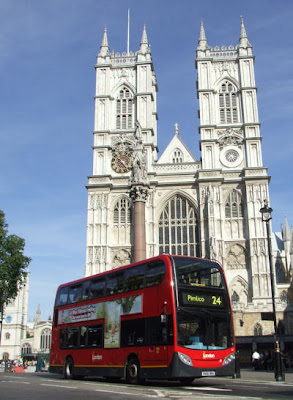 To set the scene, the first post is from my home city, London. Capital city of England, Great Britain and the United Kingdom. Host city for the 2012 Olympic and Paralympic Games. Home to many well-known sights, including its world-famous red double-decker buses.
To set the scene, the first post is from my home city, London. Capital city of England, Great Britain and the United Kingdom. Host city for the 2012 Olympic and Paralympic Games. Home to many well-known sights, including its world-famous red double-decker buses. London does not have trams - at least, not in the city centre (there is a tram system serving outer suburbs in South London, I may come back to that in a future post). Central London does, however, have a very extensive network of bus routes which operate at high frequencies. The network is co-ordinated by Transport for London (TfL), with the buses operated by a number of private companies on TfL’s behalf.
London does not have trams - at least, not in the city centre (there is a tram system serving outer suburbs in South London, I may come back to that in a future post). Central London does, however, have a very extensive network of bus routes which operate at high frequencies. The network is co-ordinated by Transport for London (TfL), with the buses operated by a number of private companies on TfL’s behalf.
Most buses operating in Central London are modern double-deckers with two doors.
Although most buses in Central London are double-deck, single-deckers are used on a small number of routes, including two of the three routes to cross the world-famous Tower Bridge.

Apart from a small number of advertising buses, it is now a TfL requirement that a uniform all-red livery is carried by all new vehicles on its services. This also applies to older vehicles as they are repainted. Previously, buses were required to be mainy red, although this could be relieved by other colours. A dwindling number of buses still carry older liveries.

Bendy buses, a concept long-established in cities abroad, entered service in London from 2002. From 2009, however, these were progressively withdrawn from service as a political decision by London’s elected Mayor. The last bendy bus was removed from the network in 2011. As the replacement buses carry fewer passengers, service frequencies have been increased to cope with passenger numbers – in some cases to a bus every 2 or 3 minutes.
Sightseeing tour buses are not part of the TfL network. Sightseeing vehicles are not therefore required to carry a red livery – and many do not.
In recent years, hybrid diesel-electric buses have started to enter service in London. Many of these will be found on routes serving Central London.



A small number of hydrogen fuel cell buses operate alongside conventional diesel-powered single deckers on route RV1, a route which links a number of tourist attractions mainly on the south bank of the Thames.
Although hybrids are becoming an established presence in Central London, conventional diesel-powered buses are still being delivered. These images show conventional diesel buses which were new in 2012 for routes operating in Central London.
Many people view the Routemaster, a double-decker with an open platform for passengers to board and alight at will, as a true London icon. The first prototype entered service in 1956, and several hundred of them were still operating into the new Millennium. A small number of the type remain in service even today, 7 days a week, on the Central London sections of two routes, the 9 and 15, operating alongside modern double-deckers. The continued operation of Routemasters on TfL services requires generous levels of subsidy.
Since 2005, these Routemasters are the only vehicles operating on the London bus network which are not wheelchair-accessible.
Other Routemasters can often be seen in London, operating special events services, private hires and themed tours.
In 2009, a competition was launched to design a New Bus for London. One stipulation was that it must have an open rear platform, like the Routemaster.

The as yet un-named new bus is a hybrid diesel-electric double-decker, with two staircases and three entrances. The first prototypes have now entered service on route 38.


Having an open platform at the rear means a second crew member is required to ensure the safety of passengers boarding and alighting. However, the platform can be closed off with a door at quiet times, meaning that the vehicle can be operated by a driver alone.
The protoype vehicles weigh a hefty 12.65 tonnes, heavier than other double-deckers. This limits their total capacity to 77 passengers, compared to around 85-90 on contemporary double-deckers (both conventional diesel and diesel-electric hybrid) - or more than 120 on the bendy buses which had been used on the busiest services, including the 38.
London's Mayor has pledged that 600 of the New Bus for London design will enter service by 2016. Is this the future of London’s buses?


































No comments:
Post a Comment